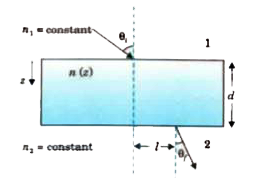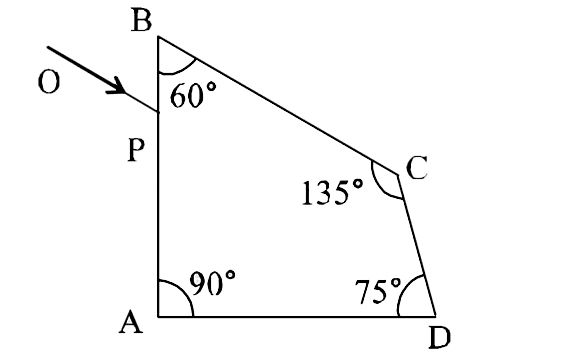Complete Solutions to OBJECTIVE TYPE QUESTIONS (C. MULTIPLE CHOICE QUESTIONS) of chapter RAY OPTICS AND OPTICAL INSTRUMENTS of Class 12 book with complete answers and questions
| Class 12 | PHYSICS |
| Chapter | RAY OPTICS AND OPTICAL INSTRUMENTS |
| MODERN PUBLICATION | OBJECTIVE TYPE QUESTIONS (C. MULTIPLE CHOICE QUESTIONS) |
| Number Of Questions | 25 |
| Academic Year | 2023-24 |
When we look at some object through our eyes then image formed on the retina is
View SolutionA ray of light travelling straight bends by a small but fixed angle. It may be due to
View SolutionConsider three geometrically identical concave lenses A, B and C. A is made of material of refractive index `mu_(1)`, B is made of material of refractive index `mu_(2)`. Lens C is constructed in such a way that half of the lens above principal axis is made of material of refractive index `mu_(1)`, and half of the lens below principal axis is made of material of refractive index `mu_(2)`. Image of an object O as shown in figure is formed at `I_(1)` when lens A is used and the image is formed at `I_(2)` when lens B is used at the same location. Now the lens C is placed at the same location.

View SolutionIn which of the following the final image is erect?
View SolutionDistance between a candle and screen is D. A convex lens of focal length 20 cm is brought in between them and it is found that real image of candle can be formed on the screen for some position of lens.
View SolutionWhich of the following entities related to spherical mirrors do not depend on whether rays are paraxial or not ?
View SolutionWhich of the following always forms virtual image for real objects ?
View Solution
An object O is placed at the bottom of a container in which water is filled up to a height of 8m. Refractive index of water is `4//3`. OAB is a vertical line. Observer is looking at O from point E as shown in figure. For the observer, position of O will appear to be
View SolutionThe focal length of the objective of a compound microscope is `f_0` and its distance from the dyepiefe is L. The object is placed at a distance u from the objective. For proper working of the instrument.,
View SolutionLight ray is travelling from a medium of refractive index `mu` in to air. Angle of incidence at the interface is `53^(@)`. Light ray is found to suffer total internal reflection. Select possible values of `mu` from the following :
View SolutionAstronomical telescope is used to observe a planet and final image of the planet is found to be formed at infinity. Focal length of objective lens is 20 m and that for the eyepiece is 4 cm.
View SolutionConvex lens of focal length f is used as simple microscope. D is the least distance for distinct vision.
View SolutionFor a light ray passing through a prism
View SolutionThere is a solid transparent sphere with a point object embedded at its centre. Apparent location of the point object will be
View SolutionThere is a thin double convex lens having surfaces of radius of curvature R and 2R. Lens is kept in air and refractive index of the material of the lens is `mu`. Focal length of the lens
View SolutionConvergent beam of light is passed through a diverging lens. Light rays after passing lens
View SolutionA convergent beam is incident on a convex mirror. Reflected light
View SolutionIdentical objective lenses are used to make Astronomical telescope and Galilean telescope. Focal length of objective for both is `f_(o)`. Focal length of eyepiece for both is also same and equal to `f_(e)`. Final image is formed at infinity in both the telescopes.
View SolutionProperly cut diamond sparkles because
View SolutionA convex lens is used to form image of an object on screen. When half of the lens is covered by painting black on it, then
View SolutionA transparent slab of thickness d has a refractive index n(z) that increases with z. Here z is the vertical distance inside the slab, measured from the top. The slab is placed between two media with uniform refractive indices `n_(1) and n_(2) (gtn_(1))`, as shown in the figure. A ray of light is incident with angle `theta_(i)`, from medium 1 and emerges in medium 2 with refraction and `theta_(f)`, with a lateral displacement l.

Which of the following statement(s) is (are) true ?
View SolutionA plano-covex lens is made of a material of refractive index n. When a small object is placed 30cm away in front of the curved surface of the lens, an image of double the size of the object is produced. Due to reflection from the convex surface of the lens, another faint image is observed at a distance of 10 cm away from the lens. Which of the following statement (s) is (are) true?
View SolutionA transparent thin film of uniform thickness and refractive index `n_(1)``=1.4` is coated on the convex spherical surface of radius R at one end of a long solid glass cylinder of refractive index `n_(2)``=1.5`, as shown in the figure. Rays of light parallel to the axis of the cylinder traversing through the film from air to glass get focused at distance `f_(1)` from the film, while rays of light traversing from glass to air get focused at distance `f_(2)` from the film, Then `

View SolutionA ray OP of monochromatic light is incident on the face AB of prism ABCD mear vertex B at an incident angle of `60degree` (see figure). If the refractive index of the material of the prism is `sqrt3`, which of the following is (are) are correct? `

View SolutionFor an isosceles prism of angle A and refractive index `mu`, it is found that the angle of minimum deviation `delta_(m) = A`. Which of the following options is/ are correct ?
View Solution
OBJECTIVE TYPE QUESTIONS (C. MULTIPLE CHOICE QUESTIONS) questions and complete solutions for chapter RAY OPTICS AND OPTICAL INSTRUMENTS of MODERN PUBLISHERS PHYSICS (HINGLISH) of Class 12
All Exercises from MODERN PUBLICATION Class 12 PHYSICS RAY OPTICS AND OPTICAL INSTRUMENTS
- CHAPTER PRACTICE TEST
- Conceptual Questions
- Higher Order Thinking Skills & Advanced Level (QUESTIONS WITH ANSWERS)
- NCERT (EXemplar Problems Obejective Questions) (Multiple Choice Questions (Type-I)
- NCERT (EXemplar Problems Obejective Questions) (Multiple Choice Questions (Type-II)
- NCERT (Exemplar Problems Subjective Questions) (Very Short Answer Type Questions)
- NCERT FILE SOLVED (TEXT BOOK EXERCISES)
- OBJECTIVE TYPE QUESTIONS (A. MULTIPLE CHOICE QUESTIONS)
- OBJECTIVE TYPE QUESTIONS (ASSERTION REASON TYPE QUESTIONS)
- OBJECTIVE TYPE QUESTIONS (B. MULTIPLE CHOICE QUESTIONS)
- OBJECTIVE TYPE QUESTIONS (C. MULTIPLE CHOICE QUESTIONS)
- OBJECTIVE TYPE QUESTIONS (D. MULTIPLE CHOICE QUESTIONS)
- OBJECTIVE TYPE QUESTIONS (INTEGER TYPE QUESTIONS)
- OBJECTIVE TYPE QUESTIONS (JEE (ADVANCED) FOR IIT ENTRANCE)
- OBJECTIVE TYPE QUESTIONS (JEE (MAIN) & OTHER STATE BOARDS FOR ENGINEERING ENTRANCE)
- OBJECTIVE TYPE QUESTIONS (MATCHING TYPE QUESTIONS)
- OBJECTIVE TYPE QUESTIONS (MATRIX MATCH TYPE QUESTIONS)
- PRACTICE PROBLEMS (1)
- PRACTICE PROBLEMS (10)
- PRACTICE PROBLEMS (11)
- PRACTICE PROBLEMS (2)
- PRACTICE PROBLEMS (3)
- PRACTICE PROBLEMS (4)
- PRACTICE PROBLEMS (5)
- PRACTICE PROBLEMS (6)
- PRACTICE PROBLEMS (7)
- PRACTICE PROBLEMS (8)
- PRACTICE PROBLEMS (9)
- Revision Exercises (Additional Questions)
- Revision Exercises (Fill in the Blanks)
- Revision Exercises (Long Answer Questions)
- Revision Exercises (Numerical Problems)
- Revision Exercises (Short Answer Questions)
- Revision Exercises (Very Short Answer Questions)
- SOLVED EXAMPLES
- Tough & Tricky (PROBLEMS)